
The Aizoaceae, or fig-marigold family, is a large family of dicotyledonous flowering plants containing 135 genera and about 1800 species. They are commonly known as ice plants or carpet weeds. They are often called vygies in South Africa and New Zealand. Highly succulent species that resemble stones are sometimes called mesembs.

Grevillea, commonly known as spider flowers, is a genus of about 360 species of evergreen flowering plants in the family Proteaceae. Plants in the genus Grevillea are shrubs, rarely trees, with the leaves arranged alternately along the branches, the flowers zygomorphic, arranged in racemes at the ends of branchlets, and the fruit a follicle that splits down one side only, releasing one or two seeds.

Lechenaultia is a genus of flowering plants in the family Goodeniaceae, the species native to Australia with one species also occurring in New Guinea. Plants in the genus Lechenaultia are glabrous shrubs or herbs with needle-shaped leaves, more or less sessile flowers with five sepals and five blue, white, or yellow and red petals in two unequal lobes, the fruit an elongated capsule.

Nicholas Edward Brown was an English plant taxonomist and authority on succulents. He was also an authority on several families of plants, including Asclepiadaceae, Aizoaceae, Labiatae and Cape plants.

Frithia is a genus of succulent plants in the family Aizoaceae, indigenous to several small rocky areas in the vicinity of Gauteng Province, South Africa.

Grevillea concinna, commonly known as red combs or elegant grevillea, is a species of flowering plant in the family Proteaceae and is endemic to the south-west of Western Australia. It is a spreading to erect shrub with mostly linear to narrow wedge-shaped leaves sometimes with a sharp point on the tip. Flower colour varies with subspecies.
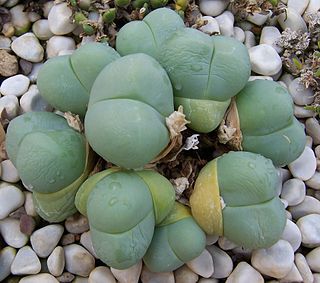
Gibbaeum is a genus of about 21 species of small succulent plants of the family Aizoaceae, indigenous to the Little Karoo region of South Africa. The name "Gibbaeum" comes from the Latin gibbosus (hunchback)
Alistilus is a genus of flowering plants in the legume family, Fabaceae. It belongs to the subfamily Faboideae.
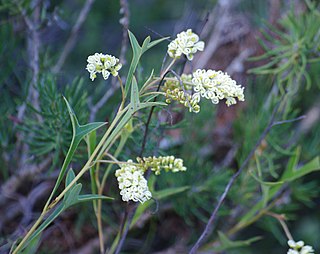
Grevillea synapheae, the catkin grevillea, is a shrub in the family Proteaceae. It is endemic to the southwest of Western Australia, occurring in low heathland.
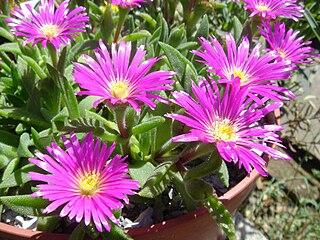
Delosperma sutherlandii is a dwarf perennial plant, native to South Africa. It forms a dense lawn with abundant, long-lasting flowering. It will reach sizes of 60 cm in diameter and approximately 10–15 cm tall, with possibly the largest flowers of its type.
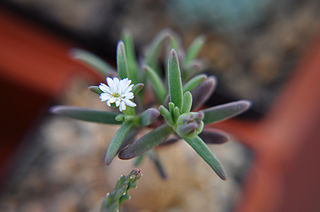
Delosperma napiforme is a dwarf perennial plant, native to the French Island of Réunion, but also now found in Madagascar. It has white flowers
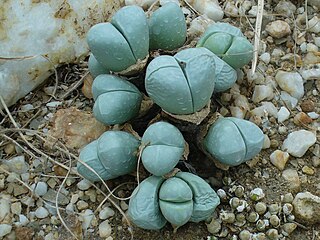
Oophytum is a genus of succulent plants native to South Africa. Both species are endemic to the Knersvlakte. Egg-shaped Oophytum plants develop two leaves opposite each other per season. At the end of winter the outer pair forms a sheath from which the new pair of leaves develop. Water cells are visible on the soft leaves giving them a shimmering appearance. The flowers, produced in winter, are white, pink, or a combination of both.

Gibbaeum heathii is a species of succulent plant in the genus Gibbaeum, endemic to South Africa.

Stapelia hirsuta, common name starfish flower or carrion plant, is a species of flowering plant belonging to the family Apocynaceae.
Zeuktophyllum is a succulent plant in the family Aizoaceae.
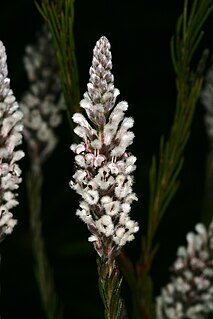
Spatalla propinqua, the lax spoon, is a flower-bearing shrub belonging to genus Spatalla, and forming a part of the fynbos vegetation. The plant is native to the Western Cape, South Africa.
Spatalla mollis, the woolly spoon, is a flower-bearing shrub that belongs to the genus Spatalla and forms part of the fynbos. The plant is native to the Western Cape, South Africa.
Leucadendron gydoense, the Gydo conebush, is a flower-bearing shrub that belongs to the genus Leucadendron and forms part of the fynbos. The plant is native to the Western Cape, South Africa.

Paranomus tomentosus, the hairy-leaf tree sceptre, is a flower-bearing shrub that belongs to the genus Paranomus and forms part of the fynbos. The plant is native to the Western Cape, South Africa.














